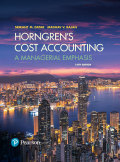
Costs-of-quality analysis. Safe Travel produces car seats for children from newborn to 2 years old. Safe Travel’s only problem with its car seats was stitching in the straps. The problem can usually be detected and repaired during an internal inspection. Inspection costs $5.00 per car seat, and repairs cost $1.00 per car seat. All 200,000 car seats were inspected last year, and 5% were found to have problems with the stitching. Another 1% of the 200,000 car seats had problems with the stitching, but the internal Inspection did not discover them. Defective units that were sold and shipped to customers are shipped back to Safe Travel and repaired. Shipping costs are $8.00 per car seat, and repair costs are $1.00 per car seat. Negative publicity will result in a loss of future contribution margin of $100 for each external failure.
- 1. Identify total costs of quality by category (appraisal, internal failure, and external failure).
- 2. Safe Travel is concerned with the high up-front cost of Inspecting all 200,000 units. It Is considering an alternative internal Inspection plan that will cost only $3.00 per car seat inspected. During the internal inspection, the alternative technique will detect only 3.5% of the 200,0 car seats that have stitching problems. The other 2.5% will be detected after the car seats are sold and shipped. What are the total costs of quality for the alternative technique?
- 3. What factors other than cost should Safe Travel consider before changing inspection techniques?
Want to see the full answer?
Check out a sample textbook solution
Chapter 19 Solutions
EBK HORNGREN'S COST ACCOUNTING
- Palladium, Incorporated recently lost a portion of its records in an office fire. The following information was salvaged from the accounting records. Cost of Goods Sold $ 72,500 Work-in-Process Inventory, Beginning 13,500 Work-in-Process Inventory, Ending 10,500 Selling and Administrative Expense 18,750 Finished Goods Inventory, Ending 19,125 Finished Goods Inventory, Beginning ?question mark Direct Materials Used ?question mark Factory Overhead Applied 13,500 Operating Income 14,825 Direct Materials Inventory, Beginning 11,675 Direct Materials Inventory, Ending 6,525 Cost of Goods Manufactured 67,050 Direct labor cost incurred during the period amounted to 1.5 times the factory overhead. The Chief Financial Officer of Palladium, Incorporated has asked you to recalculate the following accounts and to report to him by the end of the day. What is the amount of direct materials purchased?arrow_forwardOn December 31, 2022, Akron, Incorporated, purchased 5 percent of Zip Company's common shares on the open market in exchange for $15,650. On December 31, 2023, Akron, Incorporated, acquires an additional 25 percent of Zip Company's outstanding common stock for $93,500. During the next two years, the following information is available for Zip Company: Year Income Dividends Declared Common Stock Fair Value (12/31) 2022 $ 313,000 2023 $ 70,000 $ 7,800 374,000 2024 90,000 15,100 476,000 At December 31, 2023, Zip reports a net book value of $294,000. Akron attributed any excess of its 30 percent share of Zip's fair over book value to its share of Zip's franchise agreements. The franchise agreements had a remaining life of 10 years at December 31, 2023. Required: Assume Akron applies the equity method to its Investment in Zip account: What amount of equity income should Akron report for 2024? On Akron's December 31, 2024, balance sheet, what amount is reported for the…arrow_forwardCalculate JCI's projected free cash flow; the tax rate is 25%. Enter your answer in millions. For example, an answer of $1.23 million should be entered as 1.23, not 1,230,000. Round your answer to two decimal places. $ ? What is JCI's current intrinsic stock price (the price on 6/30/2021)? What is the projected intrinsic stock price for 6/30/2022? FCF is expected to grow at a constant rate of 5%, and JCI's WACC is 9%. The firm has 800 million shares outstanding. Round your answers to the nearest cent. Intrinsic stock price on 6/30/2021: $ ? Intrinsic stock price on 6/30/2022: $ ? What is the projected intrinsic stock price on 7/1/2022 if JCI distributes the cash as dividends? Round your answer to the nearest cent. $ ? What is the projected intrinsic stock price on 7/1/2022 if JCI distributes the cash through stock repurchases? Round your answer to the nearest cent. $ ? How many shares will remain outstanding after the repurchase? Enter your answer in millions. For example, an…arrow_forward
 Cornerstones of Cost Management (Cornerstones Ser...AccountingISBN:9781305970663Author:Don R. Hansen, Maryanne M. MowenPublisher:Cengage Learning
Cornerstones of Cost Management (Cornerstones Ser...AccountingISBN:9781305970663Author:Don R. Hansen, Maryanne M. MowenPublisher:Cengage Learning
